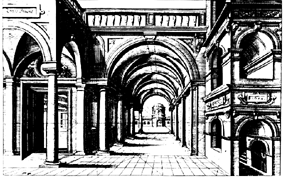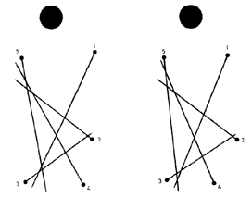
Qualitative Aspects of the Stereoscopic Image
first published in Stereoscopy, December, 1992
by Ray Zone, Los Angeles, California, United States
One of life's most fulfilling moments occurs in that split second when the familiar is suddenly transformed into the dazzling aura of the profoundly new...These breakthroughs are too infrequent, more uncommon than common; and we are mired most of the time in the mundane and the trivial. The shocker: what seems mundane and trivial is the very stuff that discovery is made of. The only difference is our perspective, our readiness to put the pieces together in an entirely new way and to see patterns where only shadows appeared just a moment before.
-Edward B. Lindaman, Thinking in Future Terms, Broadman Press, Nashville, 1978
Looking at the world with two forward-facing eyes, we simultaneously perceive two discrete images. This binary visual pair is reconciled in the brain to form what Bela Julesz terms the cyclopean image containing spatial information and depth cues. The binocular images are synthesized by the brain and the visual disparities with parallax differences are encoded together for stereopsis, the perception of depth.
This obvious but mysterious fact has been understood for a little over a century, and scientists are still attempting to trace the mechanisms by which the cyclopean image is synthesized from the stereo pair. The stereoscopic image is inherently interactive whether it is photographic in nature or a cartoon. The stereofusion necessary to produce the 3-D effect creates a cerebral construct that by nature has only the most tangential relationship to reality. Stereo photographer Stan White has perceptively remarked upon this aspect of stereography in the introduction to his book Beyond the Third Dimension:
For those who are fortunate in being psycho-physically vulnerable to its spell, the stereo image is magical. Like any worker in the field of visual expression, the photographer may fill his images with the real or with the surreal, but the stereo photographer is unique in that his medium is surreal. How else can we explain the dream-like experience when viewing the stereo-image?--an experience that was absent when the reality itself was observed. It is this quality of evoking a kind of day-dream that sets the stereo image apart from its two-dimensional counter-parts. The stereo image must never be considered an adjunct to the planar photograph, for the essential difference is qualitative not quantitative.
The photographic art, whether 3-D or not, presents a spurious illusion of documentary realism. We have a cultural bias whereby photographic imagery is invested with a credibility that it often does not merit. We overlook the fact that we are looking not at reality itself, but an image produced through a greatly distorted mirror which still retains a deceptive semblance of the real world. One of the primary tenets of modern art has been to tear down the spurious realism that painters since the Renaissance had been busy perfecting. Up to the 20th century, art had made use of a scientifically organized system of spatial representation called perspective. Utilizing a single visual pathway through space toward a vanishing point, perspective is a monocular illusion of optical depth, an art for one eye. Edmund Carpenter, in his McLuhanesque essay titled Oh, What a Blow that Phantom Gave Me!, summarizes:
To depict a whole object on a flat surface, literate man employs three-dimensional perspective; he shows only that surface visible from a single position at a single moment. In short, he fails.

An example of single point perspective-art for one eye
Carpenter also makes some cogent remarks on the differences between photographic and line art or cartoon imagery, and how we perceive them. These differences are reinforced and amplified in character wben the images in question are perceived with true binocular stereopsis. Carpenter is not addressing stereography per se, but the implicit volumetric character of different kinds of images, whether they make use of continuous tone and shading as in a photograph, or line art with a hard edge:
Photography emphasizes the world of pure sight: continuity, gradations, shadings. No intervals, no interface. The latter belong to touch, not sight, and are expressed visually by cartoon and hard-edge art, not photography.
In defining aspects of cartoon art, Carpenter's observations shed light on that qualitatively surreal impression that 3-D comics and View-Master reels with cartoon imagery generates. Perhaps it is the combination of visual coding, the patently unreal nature of cartoon art, in combination with the perceptual realism of stereopsis, that creates that surreal excitement:
Hard-edged art is a visual presentation, but the experience it evokes or conveys isn't visual; it's tactile. It's full of abrupt encounters--sudden interfaces, then emptiness.
When you have interfaces and emptiness, you have happenings. ln the world of happenings, surfaces and events collide and grind against each other, creating new forms, much as the action of dialogue creates new insights.
When photographic imagery became the prevailing standard in the 20th century, modern artists began to unleash the visual potential inherent in a flat canvas as they broke away from the classical use of perspective. Their art, from Picasso on forward, questioned how we perceive reality and invested a two dimensional canvas with multiple points-of-view and overlapping moments in time. Carpenter is quite explicit on this issue:
Two-dimensional perspective permits many times, many spaces, but three- dimensional perspective permits only one time, one space. The realistic expression of a photograph records a single moment in time, observed from a single point in space.
Similarly, Graham Collier in his drawing textbook, Form, Space and Vision, champions the tenets of modernism and the destruction of conventional perspective:.
Effective as perspective is, however, it becomes a deadening influence on an artist's natural way of seeing things once it is accepted as a system--as a mechanical formula.
So, ironically enough, it appears that in some respects two-dimensional imaging, as in primitive and abstract art, is actually a more reflexive and inclusive means of visualization in the round. Marshall McLuhan, in Understanding Media, further enumerates some of the effects that perspective has had upon our modes of thinking:
In TV the illusion of the third dimension is provided slightly by the stage sets in the studio; but the TV image itself is a flat, two-dimensional mosaic. Most of the three-dimensional illusion is a carry-over of habitual viewing of film and photo. For the TV camera does not have a built-in angle of vision like the movie camera. Eastman Kodak now has a two-dimensional camera that can match the flat effects of the TV camera. Yet it is hard for literate people, with their habit of fixed points of view and three-dimensional vision, to understand the properties of two-dimensional vision. If it had been easy for them, they would have had no difficulties with abstract art, General Motors would not have made a mess of motorcar design, and the picture magazine would not be having difficulties now with the relationship between features and ads.
The stereoscopic image is an interactive visual construct extrapolated by the mind from binocular vision. We look at a conventional photograph or painting. But our eyes, physically working at accommodation and convergence, look through a stereoscopic picture, as in a window, and follow visual pathways along a continuous field of depth. The mystery is that those visual pathways exist only in the mind, having been created there from the dual photonic stream of the visual field.

Requiring no viewing device, this is an
Amazingly enough, the optical muscles of the eye work vigorously in the pursuit and generation of this visual experience despite its illusional basis. The eye muscles physically move and create a realistic phantom! Even Nicolas Valyus, in his rigorously technical book, Stereoscopy, makes mention of this idea:
The three dimensional representation of the object may be real (i.e. a physical copy of the original object), or it may be false in the sense of being an optical image, as formed by a mirror. The optical spatial image may be artificially created in the mind of the observer without any objectively real reconstruction of a three-dimensional image.
This idea is global and transcends stereography. We only think we know the world that we see. But it is actually a construct, a photonic ghost, completed by our perceptions from very little information. As stereographers, we rigorously pursue those technical standards which enable us to invest our phantoms with the most deceptive realism. The surrealist artists, early in the 20th century, explored our perception of reality in any number of ways. Man Ray, a great 2-D black and white photographer, was well aware of our place in the universe when he wrote:
As for being a purist to the extent of preferring old, silent, black and white film, this criticism is purely arbitrary because I insisted from the start on sound accompaniment, longed for the use of color and three-dimensions, even hoped for the addition of the sensations of warmth, cold, taste and smell to film, so that lastly the spectator, coming out in to the fresh air of the street, could be totally in enjoyment of all his senses, with the added advantage of being the principal actor!
REFERENCES
